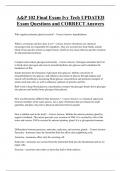A&P 102 Final Exam Ivy Tech UPDATED
Exam Questions and CORRECT Answers
Who regulates pituitary gland secretion? - Correct Answer- hypothalamus
What is a hormone and how does it act? - Correct Answer- Hormones are chemical
messengers that are responsible for regulation. They are secreted into body fluids, mainly
blood. It has specific actions on target tissues, which are any tissue that has specific receptors
for that particular hormone.
Compare and contrast glucagon and insulin. - Correct Answer- Glucagon stimulates the liver
to break down glycogen and convert noncarbohydrates into glucose and it stimulates the
breakdown of fats.
Insulin promotes the formation of glycogen from glucose, inhibits conversion of
noncarbohydrates into glucose, and enhances movement of glucose through adipose and
muscle cell membranes, decreasing blood glucose concentration and promotes transport of
amino acids into cells, as well as enhances synthesis of proteins and fats.
Both work to keep blood glucose concentration constant, but glucagon breaks down glycogen
into glucose and insulin forms glycogen from glucose.
How are pheromones different than hormones? - Correct Answer- is a chemical signal sent
between members of the same species. Are a type of hormone that are released in small
quantities and play a big role in physical attraction between people.
How is inhibin used in the body? - Correct Answer- Inhibits the anterior pituitary gland by
negative feedback. This action prevents over secretion of FSH. It is secreted by cells of the
testes and ovaries. FSH is secreted by anterior pituitary gland. It is a glycoprotein hormone.
Differentiate between paracrine, autocrine, endocrine, and exocrine glands. - Correct Answer-
Paracrine - hormones enter the interstitial fluid but affect only neighboring cells.
Autocrine - hormones affect only the secreting cell.
Endocrine - hormones are secreted from the interstitial fluid into the bloodstream and act on
target cells.
Exocrine - secretions enter tubes or ducts that lead to body surfaces.
,Describe steroid hormones. - Correct Answer- Sex hormones and adrenal cortex hormones.
Steroid hormones diffuse through cell membranes and enter cytoplasm or nucleus. Then they
combine with a receptor molecule, which together bind to DNA and promote transcription of
messenger RNA. mRNA enters the cytoplasm and directs protein synthesis. Newly
synthesized proteins produce hormone's specific effects.
Describe tropic hormones. - Correct Answer- They stimulate the activity of endocrine glands
than those secreting them.
Describe normal blood: number of each cell type, pH. - Correct Answer- Describe normal
blood: number of each cell type, pH.
CLICK THE CARD TO FLIP IT
Blood is about 8% of body weight. Adult blood volume is about 5 L. RBC count is usually
4,600,000-6,200,000 in males, 4,200,000-5,400,000 in females. WBC are usually 5,000-
10,000 per cubic mm of blood. Platelets are usually 130,000-360,000 per cubic mm of blood.
Normal blood pH is around 7.4.
How does the Rh factor affect a developing fetus and its mother? - Correct Answer- Rh
positive - presence of antigen D or other Rh antigens on the RBC membranes.
Rh negative - lack of these antigens
If a mother is Rh negative and her baby is Rh positive, her antibodies form to fight Rh-
positive blood cells. If a mother is Rh positive and her baby is Rh positive, her antibodies
attack the baby's RBC. Complications can lead the baby to develop erythroblastosis fetalis or
hemolytic disease.
What antigens can be found on RBC? What antibodies can be found in the plasma? How do
these create different blood types? - Correct Answer- Type A blood has A antigens on its cell
surface and anti-B antibodies in its plasma.
Type B blood has B antigens on its cell surface and anti-A antibodies in its plasma.
Type AB blood has both A and B antigens on its cell surface and no antibodies in its plasma.
(It is the universal recipient).
Type O blood has no antigens on its cell surface, but has both anti-A and anti-B antibodies in
its plasma. (It is the universal donor).
Describe the different leukocytes and their origins. - Correct Answer- Neutrophils
Eosinophils
, Basophils
Monocytes
Lymphocytes
Compare the formed elements of the blood. - Correct Answer- RBCs, WBCs, and platelets all
act together to maintain life. RBCs transport oxygen to the body's tissues, WBCs fight
infections in the body, and platelets clot wounds that occur.
Describe the steps in clot formation. - Correct Answer- Hemostasis - the stoppage of
bleeding.
1. Blood vessel spasm - smooth muscle in blood vessel contracts
2. Platelet plug formation:
a. break in vessel wall
b. blood escapes through break
c. platelets adhere to each other, to end of broken vessel, and to exposed collagen
d. platelet plug helps control blood loss
3. Blood coagulation - clot forms (occurs extrinsically or intrinsically).
What blood types can give/receive to/from other blood types? - Correct Answer- O+ give to:
O+, A+, B+, AB+ receive: O+,O-
A+ give to: A+, AB+ receive: A+, A-, O+, O-
B+ give to: B+, AB+ receive: B+, B-, O+, O-
AB+ give to: AB+ only receive: All blood types
O- give to: All blood types receive: O- only
A- give to: A-, A+, AB-, AB+ receive: A-, O-
B- give to: B-, B+, AB-, AB+ receive: B-, O-
AB- give to: AB-, AB+ receive: AB-, A-, B-, O-
What are normal levels and percentages of RBC, WBC and platelets? - Correct Answer-
4,600,000-6,200,000 in males.
4,200,000-5,400,000 in females.
4,500,000-5,100,000 in children.




